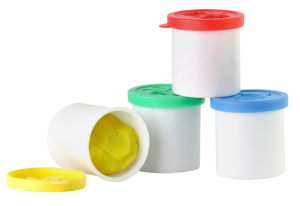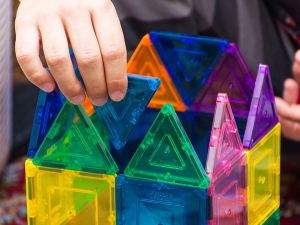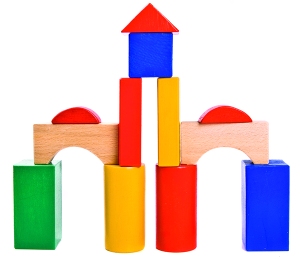The E in STEAM
The E in STEAM stands for Engineering. Engineering in STEAM helps little ones learn how and why things work. Simple engineering concepts include learning cause and effect, creating, building, and problem-solving. Create an environment that is rich in a variety of materials. Some possible building materials to incorporate into your setting are wooden blocks in various sizes, cloth blocks, cardboard boxes, paper and plastic cups, bowls and plates, nesting cups, baking sheets, and cardboard tubes from paper towels or wrapping paper. Provide assorted toys such as balls, cars, and animals. When looking for materials to bring out, think about ones that are safe, open-ended, and can be combined with other materials/toys.
Here are 7 easy Engineering ideas to incorporate into your setting:
1. Dinnerware Stack
Offer the children paper and plastic cups, bowls, and plates. Let the children freely explore and build with the materials. They might experiment with stacking and nesting bowls or stacking plates on top of bowls. Preschool-aged children will likely have more complex building ideas.
2. Playdough Designs
 Set out playdough, assorted craft sticks (regular, jumbo, wavy, etc.), chenille stems, sticks, and straws. Younger toddlers may just stick the materials into the playdough. Older children may try building, designing, and creating using the materials. They may use playdough to connect the materials as they build a box, structures, cars, or shapes.
Set out playdough, assorted craft sticks (regular, jumbo, wavy, etc.), chenille stems, sticks, and straws. Younger toddlers may just stick the materials into the playdough. Older children may try building, designing, and creating using the materials. They may use playdough to connect the materials as they build a box, structures, cars, or shapes.
3. Ramps and Toy Play
Help the children experiment with building different types of ramps. They might use blocks and baking sheets, try placing boxes at an angle, use cereal boxes, or use cardboard tubes. After they have built ramps, offer them assorted toys, such as balls, cars, small blocks, and animals. The children can learn about how objects move on ramps. Which ones move fast? How do the objects stop at the bottom of the ramp?
4. Animal Bridges
Offer the children jumbo craft sticks, plastic or paper cups, and toy animals. Invite the children to think of ways to build bridges for the animals to walk across. Observe the ways they build and design with the materials. Notice their play with the animals. If frustrations arise, help scaffold and problem solve by asking questions and providing comments.
5. Magnetic Tiles Build
 Set out enclosed magnetic tiles such as Magna-Tiles®. Encourage the children to use the pieces to create structures, combine tiles to make shapes, and play in other ways. Use them on light tables to support additional science concepts such as learning about light. Preschool-aged children might enjoy drawing their completed structures with paper and colored pencils.
Set out enclosed magnetic tiles such as Magna-Tiles®. Encourage the children to use the pieces to create structures, combine tiles to make shapes, and play in other ways. Use them on light tables to support additional science concepts such as learning about light. Preschool-aged children might enjoy drawing their completed structures with paper and colored pencils.
6. Loose Parts
Loose parts are a great tool to keep children engaged with hands-on free play and learning. Be mindful and cautious about the materials you incorporate, especially with younger toddlers. Loose parts include pine cones, large pom-poms, large cottons balls, tiles, fabric, bath poufs, large spoons, whisks, lids (mason jar lids/baby food lids), unused sponges, and feathers. For preschool-aged children you can incorporate smaller materials such as washers, screws, corks, rocks, and buttons. Be sure to supervise closely. Encourage children to discover and play. For example, a pine cone to an older infant might be a ball, whereas a toddler might use it as a tree.
7. Block Centers
 Having a Block Center (called the Blocks Exploration Station in the FunShine Express curriculum) is important to children’s learning and incorporating engineering ideas into your room. Be sure to rotate materials frequently, and observe children’s interests to know what to add to the area.
Having a Block Center (called the Blocks Exploration Station in the FunShine Express curriculum) is important to children’s learning and incorporating engineering ideas into your room. Be sure to rotate materials frequently, and observe children’s interests to know what to add to the area.
What is STEAM?
STEAM stands for Science, Technology, Engineering, Art, and Mathematics. Many people think that STEAM can only be used with older, school-aged children. However, toddlers and preschoolers are naturally curious and enjoy exploring, discovering, and solving problems. STEAM can be an easy way to incorporate hands-on play and learning. Follow along to learn more about each component of STEAM and some activities to try with your little learners.
Read about the S in STEAM
Read about the T in STEAM
Read about the A in STEAM
Read about the M in STEAM
Back to blog listing